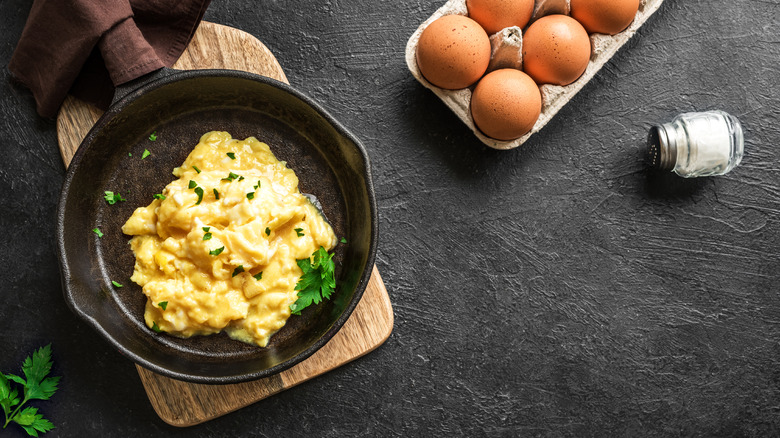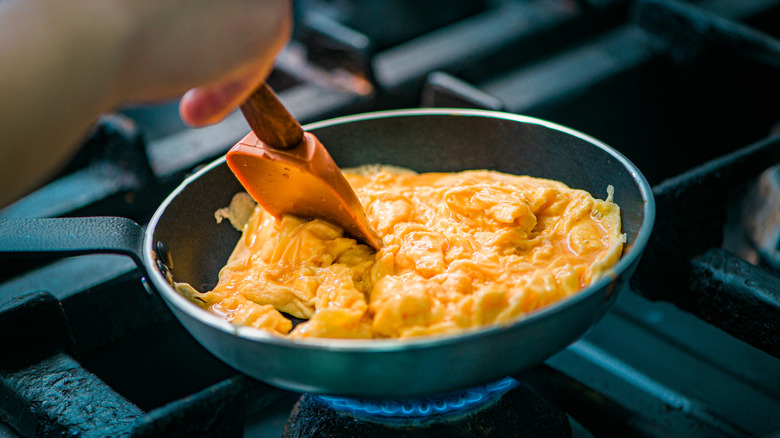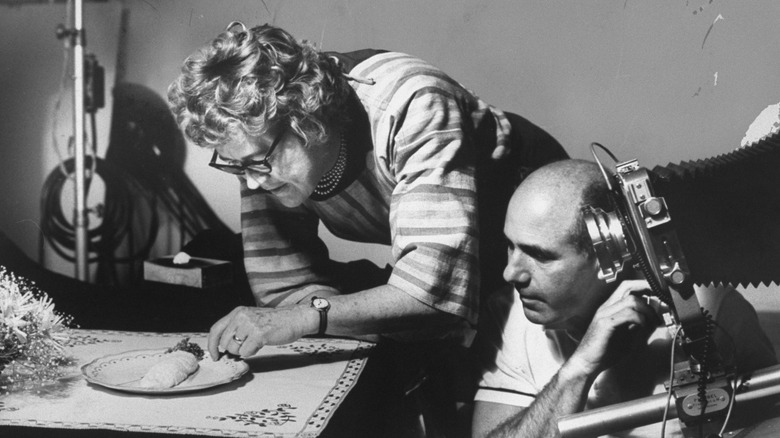Julia Child's Simple Method For Perfectly Fluffy Scrambled Eggs
Julia Child changed the way Americans cooked at home, bringing simple, fresh, French cooking to the average home cook. If it's a tip from Julia Child, you immediately know a few things. First, it's going to be simple and easy for home cooks. Second, it's going to be great. And her scrambled eggs are no exception.
Child's secret to soft, fluffy, creamy eggs couldn't be easier: Don't preheat the pan. That's it. In Mastering the Art of French Cooking, she instructs the cook to smear softened butter on the bottom and sides of the pan, pour in whisked eggs, and then place it on moderately low heat.
This is when you need patience — Child said, "Nothing will seem to happen for 2 to 3 minutes as the eggs gradually heat." If you're accustomed to making scrambled eggs in a preheated pan over a hotter burner, you've likely grown the habit of stirring early and often. With this gentler approach, that's not necessary. You're not required to frequently scrape the bottom layer of egg off the pan to keep it from overcooking before the topmost layer heats at all because the eggs are heating more consistently all the way through, forming something more like a custard. You only start to stir once they begin to thicken.
As long as you don't walk away and forget the eggs on the stove, the result is a softer French-style scramble. The eggs aren't hard and springy, but soft, fluffy, and perfect for breakfast.
Why does this work?
Eggs are easy to cook, but they're hard to cook well because they're so prone to overcooking. Anyone who has tried to get a perfect over medium egg yolk or cook a large number of poached eggs knows the fine line between undercooked, overcooked, and just right.
This is primarily because egg yolks and egg whites set at different temperatures. Egg whites, made of water and a protein called albumen, set between 144 degrees and 149 degrees Fahrenheit. Egg yolks, with their rich fat content, set between 149 and 158 degrees. If egg whites overcook, the protein bonds tighten too much, squeezing out moisture. This is what makes eggs dry and rubbery.
Scrambling eggs in a hot pan gives little margin for error. Overheating can happen in a flash, and the eggs can heat unevenly, causing overcooking of some of your scramble while trying to cook the rest. Julia Child's method of starting in a cold pan and maintaining gentle heat by moving the pan on and off the burner allows for more even cooking.
Cool at the start, cool at the end
The way you finish is as important as how you start, and eggs are no exception. Julia Child takes care to manage her cooking temperature throughout the whole process of making her scrambled eggs. She starts in a cold pan, of course, and takes the pan off the heat briefly as the eggs cook. At the end, Child removes the eggs from the heat just before they're done and adds a splash of cream, a bit of cold butter, or — as she demonstrated in a cooking video with Jacques Pepin — even a bit of reserved, uncooked egg.
As discussed, eggs are sensitive to overcooking; a couple of degrees can turn your beautiful, soft, fluffy scramble into hard egg nuggets. This can even happen after the heat has been turned off via carryover cooking; it's why you should always undercook your eggs by just a little bit. The residual heat from the pan and within the eggs themselves continue to raise the temperature of the scramble. By adding a bit of cold butter or cream, you effectively shock the eggs and stop the cooking before you lose all your hard work. Child recommends no more than two tablespoons of either for an eight-egg scramble, as the intention is fluffy, creamy eggs and not soupy eggs.


